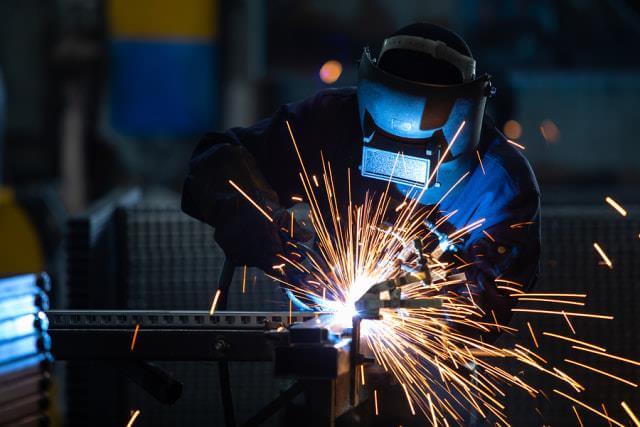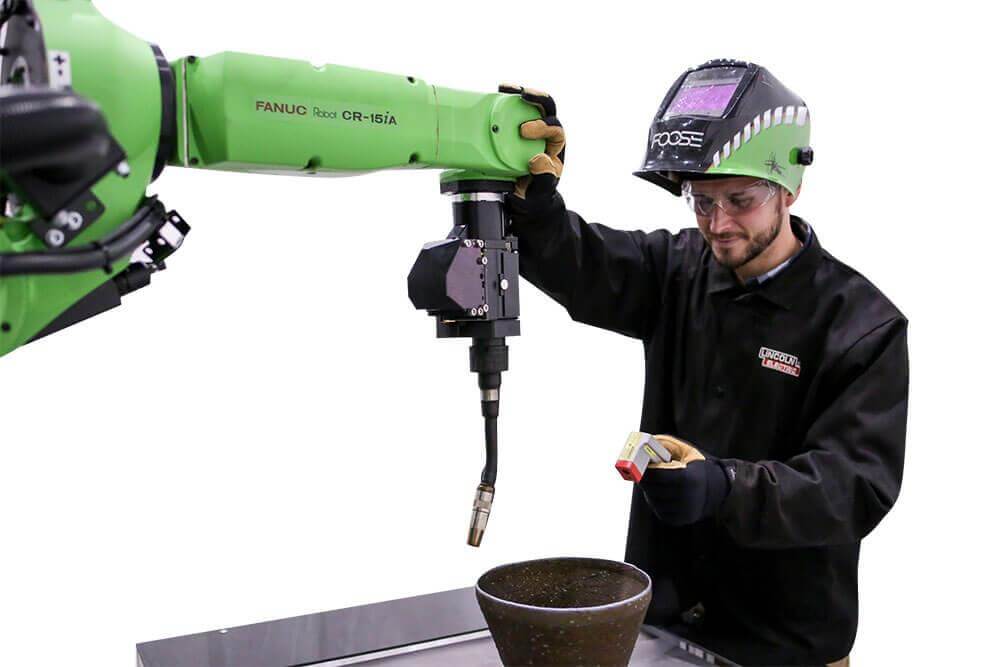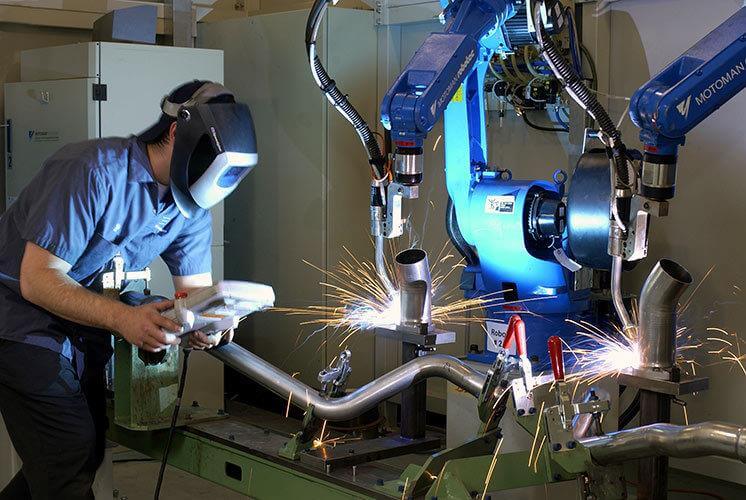Welding is one of the most common processes in metal fabrication used by industries. In other words, welding is a process used to join metals together using heat and pressure, also known as fusion. The inception of welding dated to the 18th century when metals were joined by merely heating them together. In the modern world, welding is an integral part of industrial work environments; from shipbuilding to aeronautics to car manufacturing, it is essential for metal fabrication. And now, with the robotic welding program and welding trade school, it has all become way more manageable. From its inception, welding now incorporates the advent of AI (Artificial Intelligence) and Robotics in a new age of welding technological feats.
Welding went through many evolution stages, like robotic welding program and different types of welding defined below:
| Metal Inert Gas Welding (MIG) | Welds using an electric arc. Uses consumable electrode |
| Tungsten Inert Gas Welding (TIG) | An arc between metals uses a tungsten non-consumable electrode. Inert gas acts as a shielding agent. |
| Flux Core Arc Welding (FCAW) | Two types of FCAW – Self Shielded, Gas Shielded. Self-Shielded – Flux produces gas and slag in the electrode. Gas Shielded – Gas shielding, flux is tasked with slag production. |
| Stick welding | Welding is done using a flux-covered consumable electrode. |

Welding processes were not always straightforward. Due to complex procedures, and complicated systems, the job never attracted a colossal labor force. Further, the turnover rates remained high due to hazards involved in the work. The number of young people who took up welding jobs declined because of their risk and precision experience, but most of them did not get proper training from welding school.
In addition to the employment challenges because of robotic welding automation, the industry’s designs and automation also demanded consistent innovation and upliftment of the welding techniques in the industry.
Early developments in welding advancements included automated technology solutions and robotic welding automation. Robotics or computer-controlled machinery are common ways the industry has found solutions for optimizing welding performance and consistency. While it may seem like these methods replace the need for a welding professional, automated solutions enable welders a speed and precision not possible through manual practices. This process has always led to welding being in high demand again in the industry.
Automation is not an umbrella solution for better welds. Hands-on welding professionals who have been to good welding schools will always be needed. Robotics isn’t sophisticated enough to replace the welding workforce. The welding profession requires talent and affinity for problem-solving that robots can’t compete with. Automated welding solutions help these essential welding professionals to accomplish more significant projects faster and safer.
The welding industry saw its first robotic welding solutions in1962. Robots allow welders to automate their processes and even program systems to dynamically solve complex problems for them. This also reduces many risks from high complexity welds for the welding professionals.
Robotics has helped industries to improve productivity for their welding workforce, introducing a current skillset to a traditional profession. Robots help perform fast, repeatable jobs so welders can focus on detail-oriented tasks. This tremendously improved the welding industries’ efficiency and scope for potential high complexity projects.
As robotics grew to hold an integral role in the welding industry, their potential scale was gradually realized. While robots handling basic, repeatable tasks was an impressive feat, researchers were actively identifying ways for them to be able to perform more innovative and more independent welding practices.

Collaborative robots (cobots) were introduced in 1996. Cobots are built for direct human interaction within proximity and are different from traditional robots isolated from human contact.
Till now, Robots fall into two categories; domestic service robots and industrial robots. Service robots require human interaction for proper use, while industrial robots can be programmed to do jobs on their own.
Further to the introduction of robots in welding, there was a need to make them independent of the handler. Also, initial robotic welding was for standard product size, and any deviation in product size impacted the production or quality was compromised. Therefore, an intelligent welding system was required to reduce workers’ risks from challenging welding operations and improve flexibility, quality, and productivity.
Introducing sophisticated robotic solutions enabled industries like the Internet of things (IoT), big data, artificial intelligence, cloud computing so that fabrication could be meticulously tracked and optimized. As a result, we see a recent innovation, where Cobot and artificial intelligence fusion further strengthen the welding system and improve the welding industry.
These AI-based Intelligent cobots help industries perform some non-redundant welding jobs with little or no supervision. In particular, AI-driven Cobots allow complex welding solutions in ecosystems where human health is at risk or workspaces that must be carefully climate or environmentally controlled.

Artificial intelligence is continuously evolving to advance the capabilities of the welding profession. Here are a few examples of the recent developments of AI in welding:
In industry 4.0, all industrial equipment is capable of ethernet communication, and data is shared to a joint analysis source. This analysis helps in monitoring welding processes. For example, welding parameters monitoring can continue through the data transmitted, and it can highlight any potential anomaly proactively. This allows systems to predict problems better and helps in reducing production breakdowns.
Sensors are adding additional value to the welding robots. A robot or a cobot cannot deliver good results without sensor systems allowing for performance analysis. Different sensors are available like touch, laser, vision, and through-arc. Each sensor can be used as per industrial needs and the welding function. With continuous innovation in welding, sensor innovation is critical for a better understanding of how to assist industrial improvements further.
Earlier robots in arc welding systems worked two-pass systems; the First pass was dedicated to learning the seam’s specification. The second pass was for the analysis, tracking, and then welding. However, recent technology developments allow systems to weld simultaneously and assess the proper technique necessary for an ideal weld.
With recent advancements, pipe spool fabrication supports robotic technology. With the new technology, features like machine learning algorithms, robotic welding services, and cameras can be used and built directly into the SWR’s arm. The camera captures different weld images and uses them as a reference for learning how to weld correctly. This method establishes a neural network that enables it to identify a new workspace and then configure its mechanisms independently. This enables welders to treat robotic solutions as tools and reliable coworkers for overcoming ambitious industrial projects.

The expectation from welding is to perform steady weld operations with precision consistently. Therefore, it is necessary to find technological solutions to help the human arm achieve tasks with even greater intelligence. Artificial intelligence (AI) and robots/cobots have enhanced welding technology far beyond what was initially conceived. Machine learning algorithms and advanced data availability will continue to drive advancements at a pace never seen before. All these advancements are helping the welding industry move forward. The demand for the re-education of existing welding professionals to make them understand and work with the cobots is high. With welding tech schools introducing these exciting curricula in their welding education, welding technology students who are professional welders can make full use of the opportunities and become trained and certified welding professionals. Knowledge of these welding skills and familiarity with advanced systems in welding will give their career more extraordinary highs and make them sought-after welding professionals in the industry.
With one of the top tech trade schools in Philadelphia that is a welding trade school, you can give your career a boost with their welding technology technician program, where you learn welding taught by welding industry professionals not only in theory but through hands-on experience and technological advancements like virtual reality (VR) systems in welding education and gamification techniques. This unique experience is bound to train you in a far better way and standard than robotic welding services and help you become a sought-after, trained, and certified welding professional in the career of your choice. The opportunities for you are endless. With guaranteed employment opportunities, you are ready to build a better, brighter, and stable future in the career of your choice.
Don't miss PTTI's welding training!Discover Program

Don't miss out on the training at PTTI's welding program.
